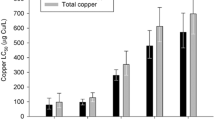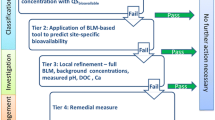Abstract
Three representative species of Cyprinidae fishes (Aristichthys nobilis, Ctenopharyngodon idellus, and Cyprinus carpio), which are abundant in Chinese surface waters, were studied to determine their sensitivity to copper (Cu) in acute exposures. We first performed acute toxicity tests to determine the Cu LC50 value for each species in water with varying characteristics. The biotic ligand model (BLM) was then calibrated using the toxicity data for these species together with binding properties specific to Cu. The BLM calibration involved the calculation of the level of Cu accumulation in the gills that resulted in 50% lethality (i.e., LA50). The LA50 values for A. nobilis, C. idellus and C. carpio were 5.16, 11.60 and 9.00 nmol g−1. The model calibrated to these data was improved by adjusting the Cu-proton exchange constant (pK CuHA-A) and dissolved organic carbon (DOC) to values of 1.84 and 4.67E-3 mol g−1, respectively. The calibrated Cu-BLM was validated for these three common fish species by comparing predicted and observed LC50 values, which were in agreement to within a factor of 2. The results of this study provide an important contribution to ecological risk assessment and establishment of water quality criteria for Cu in China.



Similar content being viewed by others
References
Arnold W, Santore R, Cotsifas J (2005) Predicting copper toxicity in estuarine and marine waters using the biotic ligand model. Mar Pollut Bull 50(12):1634–1640
Cabaniss S, Shuman M (1988) Copper binding by dissolved organic matter: I. Suwannee River fulvic acid equilibria. Geochim Cosmochim Acta 52(1):185–193
Casares MV, LI de Cabo, Seoane RS, Natale OE, Castro Ríos M, Weigandt C, AF de Iorio (2012) Measured copper toxicity to Cnesterodon decemmaculatus (Pisces: Poeciliidae) and predicted by biotic ligand model in Pilcomayo River water: a step for a cross-fish-species extrapolation. J Toxicol 2012:1–11
Constantino C, Scrimshaw M, Comber S, Churchley J (2011) An evaluation of biotic ligand models predicting acute copper toxicity to Daphnia magna in wastewater effluent. Environ Toxicol Chem 30(4):852–860
De Schamphelaere KA, Heijerick DG, Janssen CR (2002) Refinement and field validation of a biotic ligand model predicting acute copper toxicity to Daphnia magna. Comp Biochem Physiol C Toxicol Pharmacol 133(1):243–258
Di Toro DM, Allen HE, Bergman HL, Meyer JS, Paquin PR, Santore RC (2001) Biotic ligand model of the acute toxicity of metals. 1. technical basis. Environ Toxicol Chem 20(10):2383–2396
Dong S, Li D, Bing X, Shi Q, Wang F (1992) Suction volume and filtering efficiency of silver carp (Hypophthalmichthys molitrix Val.) and bighead carp (Aristichthys nobilis Rich.) J Fish Biol 41(5):833–840
Ganesh N, Gupta T, Katti R, Udupa K (2000) Acute toxicity of copper on three life stages of common carp, Cyprinus carpio Var. communis. Pollut Res 19(1):91–93
GBT (1991) Determination of the acute toxicity of substance to a freshwater fish Brachydanio rerio Hamilton-Buchanan BMEMC (in Chinese)
Hamilton MA, Russo RC, Thurston RV (1977) Trimmed spearman-karber method for estimating median lethal concentrations in toxicity bioassays. Environ Sci Technol 11(7):714–719
Hashemi S, Blust R, De Boeck G (2008) The effect of starving and feeding on copper toxicity and uptake in Cu acclimated and non-acclimated carp. Aquat Toxicol 86(2):142–147
Hayashi TI (2013) Applying biotic ligand models and Bayesian techniques: ecological risk assessment of copper and nickel in Tokyo rivers. Integr Environ Assess Manag 9(1):63–69
Hou J, Pan B, Niu X, Chen J, Xing B (2010) Sulfamethoxazole sorption by sediment fractions in comparison to pyrene and bisphenol A. Environ Pollut 158(9):2826–2832
Karan V, Vitorović S, Tutundžić V, Poleksić V (1998) Functional enzymes activity and gill histology of carp after copper sulfate exposure and recovery. Ecotox Environ Safe 40(1):49–55
Kaur K, Dhawan A (1994) Metal toxicity to different life stages of Cyprinus carpio Linn. Indian J Ecol 21(2):93–95
Marinsky JA, Gupta S, Schindler P (1982) The interaction of Cu (II) ion with humic acid. J Colloid Interf Sci 89(2):401–411
Natale OE, Leis MV (2008) Biotic ligand model estimation of copper bioavailability and toxicity in the Yacyretá Reservoir on the Paraná River. Lakes Reserv 13(3):231–244
Oecd (1994) OECD guidelines for the testing of chemicals. Organization for Economic, Paris
Pan B (2008) Physical conformation of soil organic matter and sorption characteristics with phenanthrene. Dissertation, Pku (in Chinese)
Paquin P, Santore R, Mathew R (2005) The biotic ligand model windows interface, version 2.1. 2: user’s guide and reference manual, HydroQual. Inc, Mahwah
Playle RC, Dixon DG, Burnison K (1993a) Copper and cadmium binding to fish gills: estimates of metal-gill stability constants and modelling of metal accumulation. Can J Fish Aquat Sci 50(12):2678–2687
Playle RC, Dixon DG, Burnison K (1993b) Copper and cadmium binding to fish gills: modification by dissolved organic carbon and synthetic ligands. Can J Fish Aquat Sci 50(12):2667–2677
Rehwoldt R, Menapace LW, Nerrie B, Alessandrello D (1972) The effect of increased temperature upon the acute toxicity of some heavy metal ions. B Environ Contam Toxicol 8(2):91–96
Santore RC, Di Toro DM, Paquin PR, Allen HE, Meyer JS (2001) Biotic ligand model of the acute toxicity of metals. 2. application to acute copper toxicity in freshwater fish and Daphnia. Environ Toxicol Chem 20(10):2397–2402
Tipping E (1993) Modelling ion binding by humic acids. Colloid Surf A 73:117–131
Tipping E (1994) WHAMC—a chemical equilibrium model and computer code for waters, sediments, and soils incorporating a discrete site/electrostatic model of ion-binding by humic substances. Comput Geosci 20(6):973–1023
Tipping E (1998) Humic ion-binding model VI: an improved description of the interactions of protons and metal ions with humic substances. Aquat Geochem 4(1):3–47
USEPA (2007) Aquatic life ambient freshwater quality criteria–copper. United States Environmental Protection Agency Office of Water 4304 T, Washington DC
Villavicencio G, Urrestarazu P, Carvajal C, De Schamphelaere KA, Janssen CR, Torres JC, Rodriguez PH (2005) Biotic ligand model prediction of copper toxicity to daphnids in a range of natural waters in Chile. Environ Toxicol Chem 24(5):1287–1299
Wang C, Chen H, Wu KB, An L, Zheng B (2011) Application of the biotic ligand model to predict copper acute toxicity to Medaka fish in typical Chinese rivers. Water Sci Technol 64(6):1277–1283
Wang L, Liang N, Li H, Yang Y, Zhang D, Liao S, Pan B (2015) Quantifying the dynamic fluorescence quenching of phenanthrene and ofloxacin by dissolved humic acids. Environ Pollut 196:379–385
Zhang Z (2005) Toxcity and accumulation of three heavy metals in larval carps. J Nanchang Univ 29: 292–295 (in Chinese)
Zhou P, Zhou Y, Zhou R (1988) Toxicities of two metals and two pesticides to grass carps at different development stages. Acta Scientiae Circumstantiae 8:67–71 (in Chinese)
Zhou Y, Zhou R, Nin Y (1992) Acute toxicity of copper to the grass carp, silver carp and loach under different water hardness. J Jinan Univ 13:62–66 (in Chinese)
Acknowledgements
This research was supported by the National Natural Scientific Foundation of China (41303092) and the International Copper Association (ENV-25686 A-02 YEAR 2013). We wish to thank our project officer Benny Lu for his aid and support.
Author information
Authors and Affiliations
Corresponding author
Electronic supplementary material
Below is the link to the electronic supplementary material.
Rights and permissions
About this article
Cite this article
Wang, W., Liang, Q., Zhao, J. et al. Application of Biotic Ligand Model in Predicting Copper Acute Toxicity to Carp (Cyprinidae). Bull Environ Contam Toxicol 98, 22–26 (2017). https://doi.org/10.1007/s00128-016-1999-9
Received:
Accepted:
Published:
Issue Date:
DOI: https://doi.org/10.1007/s00128-016-1999-9




